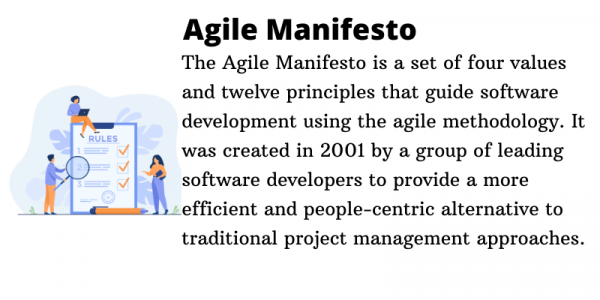Nowadays, more and more project managers are looking to do things the agile way. It means realigning core team culture, mindsets, methods, and processes to follow the agile way of working. Understandably, an Agile Manifesto was crafted to capture the essence of the agile frameworks.
In this blog post, we will take a closer look at the agile manifesto and explore how it differs from traditional project management. We will also discuss the implications of these discrepancies and offer possible solutions for resolving them.
What is the Agile Manifesto?
The Agile Manifesto is a set of four values and twelve principles that guide software development using the agile methodology. It was created in 2001 by a group of leading software developers to provide a more efficient and people-centric alternative to traditional project management approaches.
Organizations across various industries have adopted the Agile Manifesto in recent years. Despite its popularity, certain aspects of the Agile Manifesto do not align with traditional project management practices. In this blog post, we will take a closer look at the agile manifesto and explore how it differs from traditional project management. We will also discuss the implications of these discrepancies and offer possible solutions for resolving them.

The Four Values of The Agile Manifesto
The four values that are outlined in the agile manifesto are as follows:
Individuals and interactions over processes and tools
The value of the Agile Manifesto lies in its recognition of the importance of individuals and interactions over processes and tools. It is particularly relevant in the field of project management, where a project’s success often depends on a team’s effective collaboration.
By valuing individuals and interactions over processes and tools, the Agile Manifesto encourages companies to invest in their employees and create an environment that supports teamwork. In addition, this approach helps to foster a culture of innovation, as it allows for more flexible and adaptive methods.

Working software over comprehensive documentation
The value of the Agile Manifesto is that it prioritizes working software over comprehensive agile documentation. In a world where technology is constantly changing, it can be difficult to keep documentation up to date. It is why many organizations found it more efficient to focus on delivering working software instead.
The Agile Manifesto recognizes that technology changes rapidly and that documentation can quickly become outdated. As a result, it encourages organizations to prioritize working software over comprehensive documentation. Organizations have become more responsive to change and adapt to new technologies.
By focusing on working software, organizations can ensure that they are always using the most up-to-date technology. It allows them to be more efficient and more effective in their operations.

Customer collaboration over contract negotiation
In today’s business world, the importance of customer satisfaction cannot be overstated. It is essential to have close collaboration with the customer throughout the entire project. It may mean that some contractual terms need renegotiation along the way, but the result will be a much happier customer.
In contrast, if the focus is solely on negotiating the contract and adhering to its terms, the customer will likely feel frustrated and disappointed. The Agile Manifesto recognizes this fact, and its emphasis on collaboration over contract negotiation is essential in ensuring customer satisfaction.

Responding to change by following a plan
The manifesto values “responding to change over following a plan” because it recognizes that plans often need to be adjusted as new information arises. This way of working requires close collaboration between team members and frequent communication with customers or clients to ensure that the product or service being developed is meeting their needs.
While it can be challenging to adjust plans and work flexibly, the Agile Manifesto has been shown to be an effective way to work in today’s constantly changing environment.
How does the Agile Manifesto differ from Traditional Project Management?
In contrast, traditional project management relies on more rigid approaches, such as the waterfall method, which can often lead to delays and frustration.
One key difference between the two approaches is the role of the customer. In Agile, customers are actively involved in the development process, providing feedback and helping to shape the final product. It can be a major advantage, as it helps to ensure that the final product meets their needs. In traditional project management, on the other hand, customers are often left out of the loop until the very end, which can lead to problems.
Another key difference is the timeframe. Agile projects are typically completed in short sprints, which allows for more frequent delivery of new features. Traditional projects, on the other hand, often follow a longer timeline, which can lead to stagnation and delays.
Overall, the Agile Manifesto provides a more flexible and customer-centric approach to software development that can help to avoid many of the pitfalls of traditional project management.
How to Differentiate Agile and Non-agile Methodology?
There are several key ways to tell the difference between agile and non-agile project management methodologies. The most obvious is the amount of structure and documentation.
In traditional, non-agile methodology, there is typically a very high level of documentation and structure. It includes things like detailed plans, Gantt charts, and so on. Agile methodology, on the other hand, relies much more on collaboration and iteration. There is less emphasis on upfront planning and more on adaptability and agility.
Another way to tell the difference between agile and non-agile methodology is the amount of customer involvement. In traditional projects, the customer or client usually provides requirements upfront and then steps back until the project is completed.
With agile projects, however, customers are involved throughout the entire process. They provide feedback at each iteration, which helps ensure that the final product is something they will be happy with.
So, those are a few key ways to tell the difference between agile and non-agile project management methodologies. Ultimately, it comes down to preference – some people prefer the predictability of traditional projects, while others prefer the flexibility and agility of agile projects.
Examples of Scenarios that Do Not Match With the Agile Manifesto
To best understand the examples of mismatch with the agile manifesto, we break into a few common examples.
A team is developing a new software application.
The project manager creates a detailed plan that outlines every step of the process, including what each team member will be responsible for. The team members are then expected to adhere strictly to this plan. If there are any changes, the project manager must be consulted first.
A company has been contracted to build a new website for a client.
The contract stipulates that the website must be completed within six months and include specific features. Throughout the project, the team members find that the client’s needs are changing and that some of the elements specified in the contract are no longer necessary. Despite this, they continue working according to the plan to meet the six-month deadline.
An organization is working on a new product launch.
The marketing team creates a detailed plan that includes a strict timeline and milestones that must be met to ensure the launch’s success. However, as the launch date approaches, the team realizes they will only be able to meet some of the milestones. They decide to cut some corners to get the product out on time.
In each scenario, the team needs to follow the values outlined in the Agile Manifesto. Instead, they emphasize aspects such as planning, documentation, and contracts. It can lead to tension and conflict between team members and managers who are more accustomed to traditional approaches. These scenarios significantly affect the agile team culture.
The 12 Principles of The Agile Manifesto
The 12 principles of the Agile Manifesto emphasize the importance of individuals and interactions, customer collaboration, and working software. They also emphasize the importance of flexibility and agility, and the need to regularly reflect on how to become more effective.
These are the twelve principles:
- Our highest priority is to satisfy the customer through early and continuous delivery
- Welcome changing requirements, even in late development
- Deliver working software frequently (weeks rather than months)
- Close collaboration between business people and developers
- Projects are built around motivated individuals, who should be trusted
- A face-to-face conversation is the best form of communication (co-location)
- Working software is the primary measure of progress
- Sustainable development is able to maintain a constant pace indefinitely
- Continuous attention to technical excellence and good design
- Simplicity—the art of maximizing work not done—is essential
- Best architectures, requirements, and procedures emerge from self-organizing teams
- Regularly reflecting on how to become more effective and adjust accordingly.
The agile project management methodology emphasizes individuals and interactions, customer collaboration, and working software. In contrast to traditional project management methodologies, agile team requirements are mostly built around motivated individuals who are allowed to make decisions independently.
It allows for a high degree of flexibility and agility, which is vital in today’s fast-paced world. While there are some disadvantages to using an agile approach (such as the need for close collaboration between team members), the benefits often outweigh the costs.
